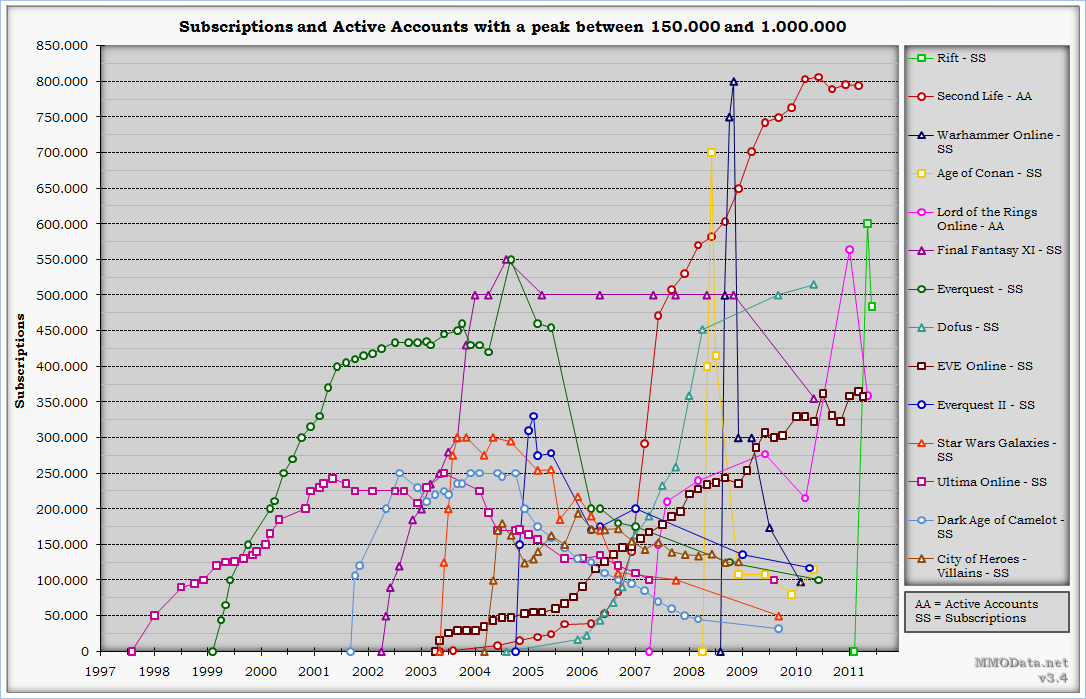The leading MMORPG of the time has lessons for how social tech phenomena may progress. We had a big early centralization, and a larger second centralization, and later lots of nostalgia, but it’s all so fractured now. What’s next for social media and our institutions?
Social media is a new technological force shaping our society. Can we find any examples in history that will give us clues as to how things will develop? Yes, the humble MMORPG was one of the earliest online social networks and it hit the mainstream a few years before Facebook. The genre’s rise and fall mirrors many developments in social media and is worthy to explore.
MMORPGs hit the mainstream with the release of EverQuest in 1999. It combined elements from MUD (multi-user dungeon) games with more approachable 3D-graphics, and quickly amassed a large number of subscriptions. The gameplay was moderately addictive (described in the early days as “EverCrack”), but most importantly the network effects meant that all your friends were playing it too. I’ll call this the “First Beautiful Time”, when you could ask any of your gamer friends what they were playing, and the answer was EverQuest, just like you were!
Of course, the monopoly of this one game didn’t last, by 2004 there were a handful of smaller MMO’s on the US market, each one striving for market share. The beautiful time had ended, some people stuck with EverQuest, but many switched to other games. Then, the biggest MMORPG of all launched, World of Warcraft.
Within a year, it was clear that WoW was a big hit, and 2-3 years after launch, it probably had more subscribers than any other MMORPG on the market combined. WoW achieved subscriber numbers of 5-10 million active accounts, compared to 200-500 thousand accounts on other popular games at the time.
For a while after WoW released, it was impossible for new MMORPGs to launch. In the sense that any promising new game would come out, gather perhaps an impressive number of subscriptions for 2-3 months, then quickly fade down to nothing and those subscribers returned back to WoW.

This was the Second Beautiful Time, everyone was just playing one game, WoW, and you could chat about it with your gamer friends, start guilds together, and experience the game together. Though, some of the costs were becoming apparent. There were nice new games out there, but they couldn’t stand up to the network effects of the giant WoW.
By 2012, subscriber numbers for the genre as a whole were falling, though some new niche games (EVE Online, etc) were able to build and retain dedicated followings. Furthermore, it turned out that for the most popular titles, there were some players who would stick with those games forever, out of a sense of nostalgia.
So, around 15 years after we started, we entered into the Great Fracturing. There will never again be an MMORPG that captures the public’s attention and mindshare like WoW did. EverQuest, WoW, and many other games from this period still exist, each with a dedicated fan base supporting their development through a sort of nostalgia. Furthermore, a new genre, the MoBA (Dota2/League of Legends) replaced the MMORPG for most gamers, promising faster action, less time commitment, and something just a little bit more “optimized” for our sense of entertainment.
Timeline:
- First Beautiful Time 1999
- Second Beautiful Time 2005
- The Great Fracturing 2014
Now consider social media, which launched and hit its stride about 5-8 years delayed from MMORPGs. We had the first beautiful time with MySpace, which gathered a niche early-adopter following in the mid 2000s. Then Facebook came along and ate everyone’s lunch, leading to a second beautiful time with an even bigger social network. But now, things are fracturing again.
As a whole, Facebook is losing users, Instagram is threatened, and TikTok is emerging as the new genre which is more apt at hacking evolution and keeping people engaged. Existing centralized networks will shrink, and there will be room for niche followings to grow and develop, but there is not much hope to see another 1 billion user classic social network start up from nothing.
So that’s the EverQuest principle: every social system that is at first strongly centralized, will fracture into specialized niches, with some sizeable nostalgia keeping things going almost indefinitely at a smaller size. But ultimately, most people will end up playing a different game.
Predictions:
- Social networks follow the pattern of an initial big centralization with early adopters, then a second bigger centralization targetting average users, then a decay down to smaller nostalgic user-bases which will outlast almost anyone’s expectations.
- No new networks can launch during the second centralization, as network effects swamp out all new competitors. ( Don’t try to compete with TikTok now, you’ll have to wait a few years)
- You will know the second centralization is over once small competitors start finding a foothold among dedicated but niche groups.
- Eventually the genre will be recognized as past its peak, and a new game will be in town (TikTok’s entertainment model replacing social-graph based networks)